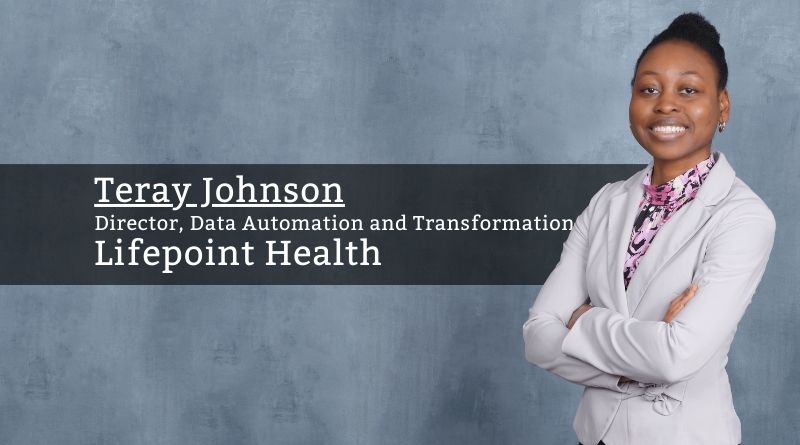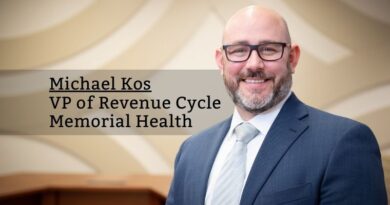The Necessity of Involving a Multidisciplinary Team in EHR AI Algorithm and Technology Creation for Clinical Decision-making
By Teray Johnson, Director, Data Automation and Transformation, Lifepoint Health
In 2020, hospitals across the world were in the throes of the COVID-19 pandemic. Burnout was rampant among administrative and clinical staff. The promise of the EHR to reduce physicians’ and nurses’ burnout and administrative burden had failed to be fulfilled during a crisis in which time was paramount, with lives hanging in the balance. The pandemic caused innovation began to bubble up from hospitals’ leaders and frontline staff, ranging from hospital-at-home to automating clinical decision-making processes within the EHR to alleviate clinicians’ administrative burden and allow them to practice at the top of their licenses. However, the abatement of the pandemic did not end the quest for innovation in care delivery.
One of the ways that LifeBridge Health, a previous health system in which I worked, innovated was by creating a clinical decision-making AI algorithm in the Cerner EHR for patients who were potential palliative care candidates. The algorithm was comprised of clinical criteria, such as the primary diagnosis and the number of admissions in the past 30 days. The algorithm created a popup each time it identified patients as palliative care-eligible. If clinicians agreed that the patient was eligible then the algorithm automatically created a palliative care consult order.
Several steps were involved in creating the algorithm. First, the palliative care team (physicians, nurse practitioners, and the VP of Palliative Care) identified a need to facilitate deciding which patients were eligible for palliative care in the EHR. The team then contacted the team of data analysts and account managers at Cerner to brainstorm a solution. Together, they decided upon an algorithm that identified patients eligible to receive palliative care. The multidisciplinary team customized the algorithm to Baltimore and Carroll County’s unique patient populations.
Additionally, LifeBridge’s data analysts, database administrators, and clinical informaticists were included to design metrics to track the algorithm’s effectiveness. As a result, the number of palliative care patients increased substantially, while the administrative burden of clinicians to place a consult order and identify potential palliative care patients was reduced. Not only were patients identified as palliative care-eligible more quickly, but length-of-stay decreased. Operations and the discharge process were streamlined so that palliative care patients were moved in a timelier fashion to different units and post-acute facilities to receive optimal care. Patients’ loved ones appreciated that their family members were being cared for. Stories of the palliative care teams’ high-quality care abounded in LifeBridge’s internal monthly magazine, on the LifeBridge website, and during awards ceremonies. Involving a multidisciplinary team, especially physicians and users, early in the algorithm’s creation was necessary for their success.
At Lifepoint Health, we include multidisciplinary teams in creating algorithms and technology solutions for clinicians. Our performance improvement and technology implementation projects are closely aligned because operations and technology are closely related. The faster and higher-quality decisions are made, the more streamlined operations are. When a need is identified, our team goes to the site in-person to map the current process. Throughout the site visit, we ask clinicians about their workflow and gather their suggestions to provide the best recommendations and technology solutions.
One of our successful projects involved streamlining the prior authorization process at Lifepoint’s primary care practices. The prior authorization process was cumbersome for physicians and administrative staff. Our team first identified pain points, researched best practices, and then found an automated solution using a vendor. We received opinions from primary care physicians and administrative staff and pilot-tested the solution in several practices for proof of concept. We received and implemented positive, constructive feedback from physicians and administrative staff. We are exploring the expansion of the platform. The automated technology has enabled the task to be shifted to a centralized administrative team, increasing physicians’ clinical capacity.
In each of these cases, the algorithms and automated solutions could not have succeeded without the feedback of the clinicians, data specialists, and administrators. Each of our teams had the following takeaways from these projects:
- Involve representatives from different departments from the beginning to the maintenance phase of the projects. Representatives include physicians, nurses, data analysts, and operations experts.
- The project never truly ends. Team members should expect to be involved for several months, or perhaps years, as the algorithm and automated solutions are refined based on evolving patient and clinician needs. Expect the metrics to evolve as additional opportunities for improvement are identified.
- Communication is paramount to success. Each of our teams continues to meet regularly to review metrics, celebrate successes, and identify opportunities for improvement. We met more frequently at the beginning of the projects to discuss scope, roles and responsibilities, metrics, and potential impacts on clinical decision-making and non-clinical operations. Identifying the opportunity costs was important in decision-making, and ensuring that all team members’ voices were heard engaged them and allowed us to make the best, data-driven decisions for physicians, nurses, patients, and the organizations.
- Identify early adopters and allow them to conduct a pilot to ensure proof of concept. Physicians are often open to new ideas and solutions but would want to be involved early in the decision-making process and algorithm creation. Play to physicians’ autonomy to gain their buy-in, and explain solutions and algorithms so that they can connect how the solutions contribute to higher-quality patient care.
By including a multidisciplinary team in creating AI algorithms and technology to automate clinical decision-making, clinicians can return to what they entered medicine for: caring for patients as they would their own loved ones.



